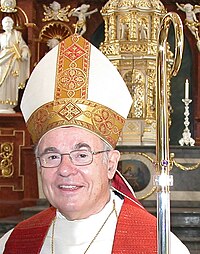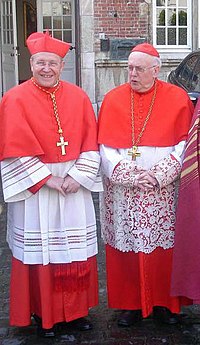Saint Gallen Group
 From Wikipedia - Reading time: 7 min
From Wikipedia - Reading time: 7 min

The Saint Gallen Group, also called the Saint Gallen Mafia, was an informal group of high ranking like-minded liberal/reformist clerics in the Catholic Church, described by the Bishop of Saint Gallen, Ivo Fürer, who hosted the discussions, as a Freundeskreis ('circle of friends')[1] – who met annually in or near St. Gallen, Switzerland, in January, to freely exchange ideas about issues in the church.
Name
[edit]The group being informal, it had no official name. "Group of St. Gallen" is what some of its members called it in their agendas, and the name has become public after a full chapter devoted to it in the biography of Cardinal Danneels, published by Church historians Karim Schelkens and Jurgen Mettepenningen;[2] "St. Gallen Group",[3] "St. Gallen Mafia" and "St. Gallen Club" are alternatives.
In the chapter devoted to the group, Danneels's biographers did not mention the word 'mafia' once. However, at the presentation of the biography in September 2015, which was televised by VTM,[4] Danneels said that the name "Group of St. Gallen" was "deftig" ('dignified', 'respectable'), "maar eigenlijk zeiden wij van onszelf en van die groep: de maffia" ('but actually we said of ourselves and of that group: the mafia'). This provoked laughter. Others later used that name too, not always jocularly.[citation needed]
History
[edit]Background
[edit]
The impetus for the discussions came from Bishop Ivo Fürer, who had been the secretary-general of the Council of the Bishops' Conferences of Europe from 1977 until 1995.[6] When in 1993 the Vatican imposed a thorough reform of this council,[7] Fürer was one of the members who felt that this meant the end of the main raison d'être of the council, viz. fostering collegiality among European bishops.[8][9] In consultation with Cardinal Carlo Maria Martini, he decided to invite a group of cardinals, archbishops and bishops for frank, collegial discussions among themselves.
Attendance
[edit]When the group met for the first time, in January 1996, Fürer invited Martini; Paul Verschuren, bishop of Helsinki; Jean Vilnet, archbishop of Lille; Johann Weber, bishop of Graz-Seckau; Walter Kasper, bishop of Rottenburg-Stuttgart (later Cardinal), and Karl Lehmann, bishop of Mainz (later Cardinal).[5]
New members, all joining by invitation and all "open-minded" were:
- 1999: Cardinal Godfried Danneels, archbishop of Mechelen-Brussels and Ad van Luyn, bishop of Rotterdam
- 2001: Cormac Murphy-O'Connor, archbishop of Westminster (later Cardinal), and Joseph Doré, archbishop of Strasbourg
- 2002: Alois Kothgasser, bishop of Innsbruck, later archbishop of Salzburg
- 2003: Achille Silvestrini, a curia Cardinal, and Cardinal Lubomyr Husar, Major Archbishop of Lviv and Metropolitan of Galicia in the Ukrainian Greek Catholic Church
- 2004: José Policarpo, Patriarch of Lisbon (in 2004).[10][11]

Whilst in Rome before the 2005 papal conclave, the cardinals who were members of the Saint Gallen Group sent their host Ivo Fürer a card saying: "We are here together in the spirit of Saint Gallen",[12] and before the conclave they came together for a talk over dinner.[13] According to an anonymous cardinal's diary excerpts which were published by Brunelli, two of them, Lehmann and Danneels, were "the thinking core" of the reformisti during the conclave. These reformisti did not want to vote for Joseph Ratzinger, and tried to prevent his election by giving all their votes to Jorge Mario Bergoglio, who thus might achieve a blocking minority.[14] They succeeded, but Bergoglio, "almost in tears", begged not to be elected.[15] Ratzinger was elected Pope Benedict XVI.
The year after Ratzinger's election, what remained of the group met for the last time. The gathering was attended by just four members: Fürer, Kothgasser, Danneels and van Luyn.[16]
Three of the remaining members, however, participated in the 2013 papal conclave: Walter Kasper, Godfried Danneels and Karl Lehmann. Cormac Murphy-O'Connor was too old to participate in the conclave, but he was present in Rome during the pre-conclave period. Unlike in 2005, there is no anonymous source to report from within the conclave on what role they played in the election of Pope Francis. According to Austen Ivereigh, the four worked in concert to advocate the election of Jorge Mario Bergoglio at the conclave, still hoping to elect a more modern leader for the Church. Also, in the first edition of his book, Ivereigh writes that "they first secured Bergoglio's assent". All four cardinals, however, denied this.[17][18][19][20]
The director of the Holy See Press Office said the cardinals were "surprised and disappointed" at what was written about them and that they "expressly denied this description of events ... with regard to the conduct of a campaign for [Bergoglio's] election".[21] The strong push back from the cardinals was primarily due to the implication that they had broken the rules set forth in para. 82 of Universi Dominici gregis and therefore excommunicated latae sententiae. In the second edition of his book, Ivereigh bolstered the cardinal's defensive positioning by replacing the phrase with: "In keeping with conclave rules, they did not ask him if he would be willing to be a candidate."[22] But he stood by the rest of his reporting.[18]
Secrecy
[edit]The founders and members of the group felt that the Vatican impeded free discussion among bishops, so meetings were held in secrecy. Members observed "a simple rule: everything could be said, no notes were taken and discretion was observed."[23]
The gatherings were revealed by Ivereigh after the group had ceased to exist in 2014, and described more extensively in 2015 in Danneels's authorized biography.[24][25]
Issues and persons discussed
[edit]The issues discussed by the group included centralism in the Church, the role of the bishops' conferences, the role and position of priests, sexual morality, the nomination of bishops and collegiality. On all these issues, the Vatican had published documents which the participants found controversial.[5]
All agreed that the prefect of the Congregation for the Doctrine of the Faith, Joseph Ratzinger, was a centralizing and conservative influence in Rome, especially as John Paul's health declined.[5] They certainly did not want Ratzinger to succeed him.
Some members deny that they discussed other names, but Fürer contradicts them, and explicitly states that Jorge Mario Bergoglio's was mentioned in the group's discussion on the impending succession of John Paul II. He adds, however, that the members never committed themselves on any candidate.[26] Bergoglio's name, however, could only have come up in Saint Gallen at the 2002 meeting. Bergoglio was only created a cardinal in February 2001, and Martini, who had met him in 1974, introduced him to some members, who knew him barely or not at all, at the extraordinary consistory of May 2001.[26] Cardinal Bergoglio did not like the way the curia ran things, and his report on the 2001 bishops' synod earned him praise from much of the hierarchy, including from the Saint Gallen Group.[27]
See also
[edit]- Catholic Church in Switzerland
- Universi Dominici gregis
- Council of the Bishops' Conferences of Europe (CCEE)
- Pact of the Catacombs
- Alta Vendita
- Squadrone Volante
References
[edit]- ^ "Aktuelles" (in German). Bistum. St. Gallen. 30 September 2015. Retrieved 16 August 2017. The diocese presents an archive of its press releases. The press release of the diocese is "Sensationsmeldung?" ('Sensational News?') dated 30 September 2015 and at the bottom of that is a link to Fürer's statement "Erklärungen von em. Bischof Ivo Fürer" ("Explanations by Bishop emeritus Ivo Fürer").
- ^ M&S 460., Karim Schelkens & Jürgen Mettepenningen Godfried Danneels: Biographie
- ^ Used by Ivereigh, among others.
- ^ "Danneels: 'Zat in soort maffiaclub'". VTM Nieuws (in Dutch). 24 September 2015. Retrieved 6 December 2018..
- ^ a b c d M&S 462.
- ^ M&S 461.
- ^ M&S 312.
- ^ M&S 213.
- ^ Pope John Paul II's motu proprio Apostolos suos was to increase the influence of the Vatican on bishops' conferences even further; see M&S 463–464.
- ^ M&S 461–471.
- ^ Some sources also name Cardinal Basil Hume as a member, but this is probably based on Marco Tosatti's misreading of Danneels's biography; see "Francesco: elezione preparata da anni". La Stampa. 24 September 2015. Retrieved 24 July 2017. The meeting of Fürer, Danneels, Hume and the French theologian Hervé Legrand in Saint Gallen that the biography mentions (M&S 217) took place in 1984, over a decade before the first meeting of the Saint Gallen Group.
- ^ M&S 472.
- ^ Ivereigh 280.
- ^ Lucio Brunelli, "Così elegemmo papa Ratzinger" in Limes 1/09. (Retrieved March 2019.)
- ^ Ivereigh 284.
- ^ M&S 473.
- ^ "Author, Cardinals Spar over Reports of Conclave Campaigning". Catholic News Agency. 4 December 2014. Retrieved 4 December 2014.
- ^ a b "Smoking Gun? Pope Francis' Critics Cite New Book in Questioning His Papacy". The Washington Post. 5 December 2014. Retrieved 5 December 2014.
- ^ "Pope Francis: How Cardinals' Conclave Lobbying Campaign Paved Way for Argentine Pontiff". The Daily Telegraph. 22 November 2014. Retrieved 5 December 2014.
- ^ "Cardinal Godfried Daneels Part of 'Mafia' Club". The Weekend Australian. 24 September 2015. Retrieved 24 July 2017.
- ^ "Vatican Press Director Denies Papal Election Details in New Book". Zenit. 1 December 2014. Retrieved 21 August 2017.
- ^ Ivereigh 354–355.
- ^ Translation of the Dutch text in M&S 462.
- ^ Ivereigh 257ff. & passim.
- ^ M&S, chapter 24.
- ^ a b Julius Müller-Meiningen, "Die Tafelrunde von St. Gallen, die Franziskus zum Papst machte" in the short-lived Swiss newspaper TagesWoche, October 2, 2015. (In German; retrieved March 2019.)
- ^ Ivereigh 263–265.
Sources
[edit]- Austen Ivereigh The Great Reformer: Francis and the Making of a Radical Pope (With an updated and expanded epilogue) (New York: Picador, 2015) ISBN 978-1-250-07499-7. In the notes: Ivereigh.
- Jürgen Mettepenningen & Karim Schelkens Godfried Danneels: Biografie (in Dutch; ISBN 978 94 6310 022 9); Karim Schelkens & Jürgen Mettepenningen Godfried Danneels: Biographie (in French; ISBN 978 94 6310 023 6) (Antwerpen: Uitgeverij Polis, 2015.) References (in the notes: M&S) are to the original Dutch version.
- Julia Meloni, The St. Gallen Mafia: Exposing the Secret Reformist Group Within the Church, Tan Books, 2021 (ISBN 9781505122879).
 KSF
KSF